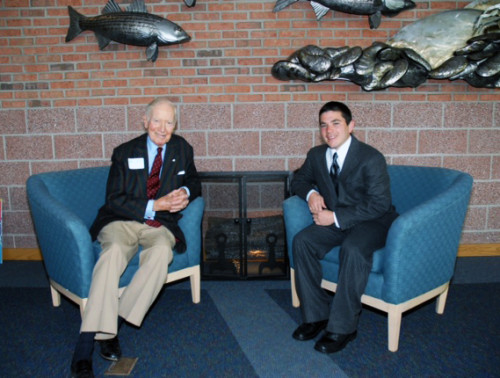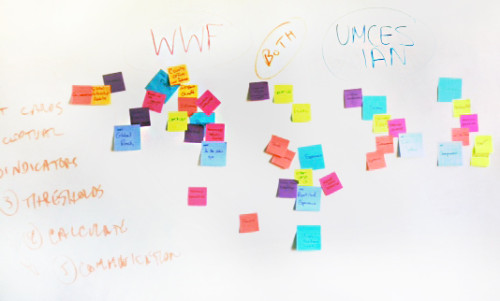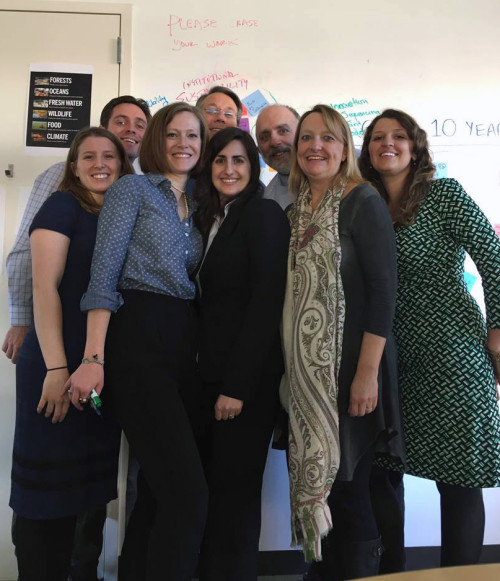Brainstorming in the Innovation Room with World Wildlife Fund
Bill Dennison ·This blog is part of the Basin Report Card Initiative: a partnership between the World Wildlife Fund (WWF) and the University of Maryland Center for Environmental Science (UMCES)
Simon Costanzo, Alex Fries and I travelled into Washington D.C. for a brainstorming session with colleagues at the World Wildlife Fund (WWF). The brainstorming took place in a cozy room located in one of the far corners of the WWF office suite. It turns out that it used to be the office of the WWF founder and former chairman, Russell Train, which I found very interesting. Russell Train (1920-2012) was the Administrator of the Environmental Protection Agency (1973-1977) soon after its creation in 1970. Several years ago, we invited Russell to the Horn Point Laboratory since he had retired to the Eastern Shore of Maryland and lived nearby. We had a 'fireside chat' which the graduate students led, which was amazing--he had been at the epicenter of some important environmental events. I recall his stories of becoming enamored with wildlife issues in Africa and how that resulted in the creation of WWF. Another enjoyable connection was when I sat down next to Chris Conner as we watched a cute video of a dancing panda at the end of general staff meeting. I had the good fortune of working with Chris when he was with the Chesapeake Bay Program and then with the University of Maryland Center for Environmental Science (UMCES) when we recruited him to head up our effort to put UMCES onto the media map. Chris is now an Environmental Policy Communicator at WWF.

WWF has converted Russell Train's office into the 'Innovation Room'. This room was painted with white paint that can be used as a giant white board. Small tables, chairs, stools, cushioned window benches and flip charts furnished the room, which encouraged people to move around and stay active. Sarah Freeman provided a delicious healthy lunch in the room, so we could munch away as we got to know one another. I was like a kid in a candy store in the Innovation Room and quickly filled up a wall of drawings in describing the climate, food, forests, freshwater, oceans and species (wildlife). The group we are interacting with focuses on freshwater, but they have additional involvement in forests and climate.

The topic of our brainstorming session was developing a global approach to environmental report cards (or scorecards) for rivers of the world. WWF and IAN are currently partnering on a report card for the Colombia reaches of the Orinoco River, but both organizations are quite interested in expanding our approach to other rivers of the world. WWF has a particular interest in 273 transboundary rivers where they are currently working and IAN is looking for ways to be more strategic about developing report cards, rather than relying on word-of-mouth and referrals to initiate new report card projects.
Following introductions of people and organizations, we conducted an exercise of developing words or phrases that depict our organizations using sticky notes and then calling out "Snap" when someone else's word or phrase was akin to one you had written. Several themes emerged from this exercise. WWF has a strong global network of field offices with 'boots on the ground', a strong global brand and extensive experience throughout the world. This global network offers the potential to replicate approaches and catalyze a global impact. IAN has a strong science background and approach, providing rigor and analytical capacity, with extensive experience in developing environmental report cards. Both organizations are staffed by highly motivated and creative people who conduct intensely collaborative projects. The combination of IAN and WWF skills and capacity appears to be a great fit. IAN's penchant for getting stuff done and WWF's network and capacity offers opportunities that transcend what each organization can accomplish alone.

The next exercise involved fleshing out a vision of what a WWF/IAN partnership could achieve. We again used sticky notes, and brainstormed what we would want to accomplish in five to ten years. Following the initial wallpapering of sticky notes, we stood back and did some grouping. We developed the following groupings for our partnership vision: 1) Global impact, 2) Institutional sustainability, and 3) Effective partnership. For global impact, the following elements were raised; a) catalyzing more effective governance, b) developing positive environmental trajectories, c) establishing transparent data analyses, d) improving funding models of development banks, and e) empowering river managers. For institutional sustainability, the following elements were raised; a) making report cards the industry standard for assessment and tracking, b) developing a sustainable model for report card production in each basin, c) prioritize philanthropic investments using report cards, d) creating dedicated funding streams for report cards, and e) maintaining ongoing innovation. For the WWF/IAN partnership, the following elements were raised; a) combining forces into integrated program, b) develop and maintain an active website for report card development and dissemination, c) 'train the trainers' to replicate report card production widely, d) establish a global network of local/regional report card programs, and e) influence river management and governance.
Various barriers to implementing this vision were identified: resistance by vested interests, lack of ongoing financial support, variable data quality, fostering local champions, evaluating effectiveness, incorporating climate change, scaling to different levels, connecting with governance and decision-makers, and empowering local resource managers. In the short time we had together, we simply identified the barriers, and we resolved that tackling each of these barriers in turn will be the subject of a future brainstorming session.

Back row (left to right): Simon Costanzo, Tom Dillon, Bill Dennison
The WWF Innovation Room is a great concept and our session was incredibly productive and rewarding. We are very excited about launching into this partnership that will advance our collective vision of achieving better conservation outcomes globally. Our mantra at IAN is to find interesting and meaningful projects, work with excellent partners and produce great products. I think that we found an interesting project, identified some excellent partners and we can produce great products together.
About the author
Bill Dennison

Dr. Bill Dennison is a Professor of Marine Science and Interim President at the University of Maryland Center for Environmental Science (UMCES).
Next Post > Reef Resilience in Townsville
Comments
-
Atika 3 months ago
Thank you for sharing this great information with us, i really appreciate your post!